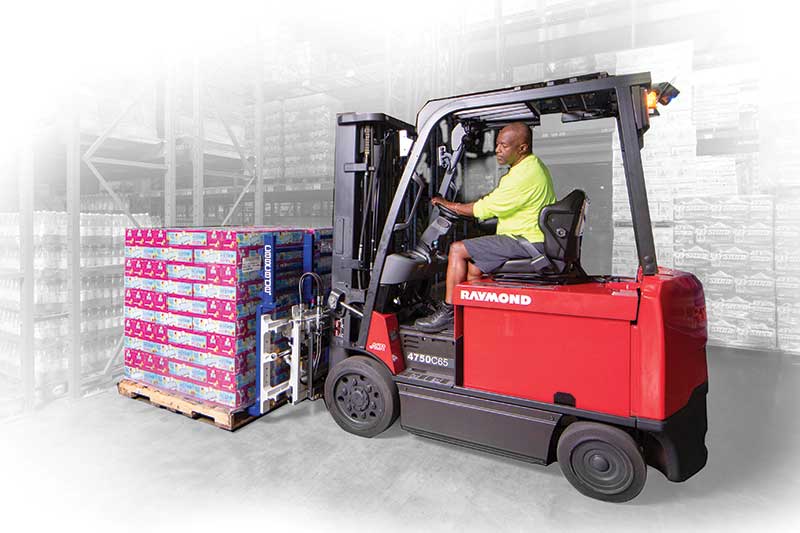Lift truck attachments as productivity enhancers
Lift truck attachments, like side positioners and clamps, can make work faster and more efficient, but they can impact the performance and set up of your forklifts.

Understanding the value of attachments comes down to appreciating how different types of attachments can increase productivity, but they also need to be viewed as part of an overall system that works in concert with your trucks, points out Tim Rice, a senior product manager with The Raymond Corp.
Popular attachment types include fork positioners that allow the forks to adjust width to fit different sized pallet openings without the operator having to leave his or her seat; various types of clamps for products such paper rolls; push/pull attachments for dealing with pallet loads that need slip sheets; or multiple load handlers can move more than one pallet load at a time.
It’s important to know how each of these attachment types can save time or help reduce product damage, but it’s also important to understand how an attachment might impact the truck itself, says Rice.
For example, attachments might slightly increase the length of the truck, impacting turning radius, and some might affect lift capacity. Trucks in a fleet that are going to be used with attachments should also be ordered with enough hydraulic functions (the correct number of hoses and valves) for the truck’s hydraulics, says Rice.
In most trucks, these functions include one to lift and lower loads; and a function to tilt the mast forward or back. On Raymond’s trucks, a standard side shift hydraulic function shifts a load left or right, adds Rice. Trucks that need additional attachments might need an extra hydraulic function as part of the truck package.
“Attachments do have to work as a system with your truck, which is why we think it’s best to work with a representative from one of our solution and support centers to determine the ideal attachments for your trucks and how they should be set up,” says Rice.
On Raymond’s lift trucks, an integrated side-shifting function reduces the head-length from the front of the mast versus a hang-on side-shifter, says Rice, which helps with maneuverability and avoids an extended load center. Trucks commonly used with other types of attachments could make use of this side-shift function for another attachment type or be ordered with an auxiliary hydraulic function.
For trucks that might need to be used with different attachment types regularly, quick disconnects allow for rapid attachment changeover from the same hydraulic function.
“Depending on how you want to use the truck, you may want to consider taking off the integral side shift to use a different attachment, or in addition to the integral side shift function, add more hydraulic functions to the truck. It’s a matter of making sure you will have enough hydraulic functions on the truck for the applications you want to perform with it. You definitely should be thinking about attachment needs when you are ordering trucks,” he adds.
In short, think of attachments and truck working together as a system to carry out distinct tasks more quickly, safely and with less chance for product damage. Manually adjusting fork width, for instance, consumes operator time versus using an onboard side-shift control; while a layer picker can mechanize manual palletizing or depalletizing tasks versus having associates on foot do it by hand.
Cascade, one of the attachment vendors Raymond works with, estimates that by using a layer picker, one forklift operator can fill orders at an average speed of 1,250 cases an hour compared to 250 cases an hour manually.
Keep in mind that certain attachments may impact a truck’s turning radius, or its lift capacity versus lifting a standard pallet with standard forks, says Rice, which is why it is best to consult with a dealer on the right combination of truck, number of hydraulic functions and attachments. It’s also useful to take a fleet-wide approach to attachment needs, adds Rice.
“In a fleet, you may have 10 lift trucks that don’t have or really need attachments, but then you might have one or two dedicated for use with attachments,” says Rice. “Or an operation might benefit from putting quick disconnects on some of its trucks that allows them to quickly move between attachments. The best approach is to talk with a sales representative and figure out what works best for your range of applications.”

Article Topics
Lift Trucks News & Resources
Case study: Optimizing warehouse space, performance and sustainability Hyster recognizes Dealers of Distinction for 2023 Carolina Handling names Joe Perkins as COO Toyota Material Handling North America appoints Mark Taggart as CFO Learn from lift truck service history Toyota Material Handling honors its top forklift dealers in North America Fleet Team expands with strategic acquisition of Forklift Training Systems More Lift TrucksLatest in Materials Handling
Geek+ and System Teknik deploy PopPick solution for pharmacy group Med24.dk Beckhoff USA opens new office in Austin, Texas Manhattan Associates selects TeamViewer as partner for warehouse vision picking ASME Foundation wins grant for technical workforce development The (Not So) Secret Weapons: How Key Cabinets and Asset Management Lockers Are Changing Supply Chain Operations MODEX C-Suite Interview with Harold Vanasse: The perfect blend of automation and sustainability Consultant and industry leader John M. Hill passes on at age 86 More Materials HandlingAbout the Author
Subscribe to Materials Handling Magazine

Find out what the world's most innovative companies are doing to improve productivity in their plants and distribution centers.
Start your FREE subscription today.
April 2024 Modern Materials Handling

Latest Resources











